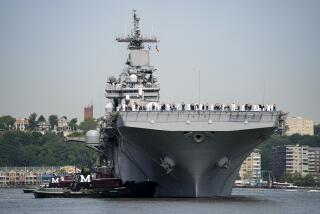Kuwaiti Tanker Gas Prince Sails With U.S. Escort
- Share via
DUBAI, United Arab Emirates — A tanker carrying liquefied petroleum gas sailed from Kuwait with an escort of U.S. warships Saturday, the first U.S. naval convoy through the perilous waters of the Persian Gulf since a supertanker was damaged by a mine nine days ago.
The 46,723-ton Gas Prince, a Kuwaiti vessel re-registered two weeks ago to carry the U.S. flag, sailed early Saturday morning, according to a reliable shipping source.
Carrying a full, 40,000-ton load of liquefied gas, the Gas Prince sailed with a convoy of American warships, the shipping source said, but the number and names of the U.S. vessels were not known.
In a related development, Italy said Saturday that--like Britain, France and West Germany--it was turning down a U.S. request that it send surface minesweepers to aid the Persian Gulf escort force.
Italian Defense Minister Valerio Zanone announced the decision, in what apparently is the final chapter in an embarrassing episode for U.S. diplomacy. U.S. Ambassador Maxwell Rabb had delivered the request from Defense Secretary Caspar W. Weinberger. In his reply, Zanone said Italy believes that freedom of navigation in the Persian Gulf can best be preserved by support for a United Nations Security Council resolution adopted unanimously two weeks ago. The resolution calls for an end to the nearly seven-year-old war between Iran and Iraq.
On July 24, the “reflagged” supertanker Bridgeton hit a mine about 18 miles west of the Iranian island of Farsi. The Gas Prince passed safely through that area about 120 miles southeast of Kuwait.
Bridgeton Now Loading
The Bridgeton’s hull was pierced by the explosion. But the 401,000-ton supertanker now is loading about 230,000 tons of crude oil, which it will transport out of the Persian Gulf on its way to dry dock for repairs.
The shipping source said that the Gas Prince left Kuwait without the Bridgeton because customers were pressing for delivery of its cargo. The ship, which is heading for Japan, is expected to complete the 550-mile journey out of the gulf in two days. The U.S. escorts will leave the ship at the entrance to the gulf, the Strait of Hormuz.
Besides mines, the Gas Prince must run a gantlet consisting of tiny islands where Iranian Revolutionary Guards have stationed armed speedboats, followed by the Strait of Hormuz, where Iran has erected launch sites for Chinese-made Silkworm anti-ship missiles.
In a report from Tehran on Saturday, the Revolutionary Guards’ naval commander, Alireza Alaie, threatened to blockade the strait if the U.S. escort of tankers continues. He said that “thousands of speedboats” are ready for conflict and will “destroy all ships headed for Kuwait” if the order comes.
U.S. Navy Criticized
“Kuwaiti ships will be more exposed to attacks if they fly the U.S. or Soviet flags, whereas they would encounter no incidents if they refuse to fly those flags,” Alaie told a Friday prayer session, according to Iran’s official news agency IRNA. “But both the United States and the U.S.S.R. will be drowned in this whirlpool, if Kuwait pursues its current policy.”
And in Washington, Rep. Les Aspin (D-Wis.), chairman of the House Armed Services Committee, had sharp criticism for the U.S. Navy. In a speech prepared for delivery in the House on Monday, Aspin scored the Navy for failing to anticipate both the mines and possibly less sophisticated attacks on the tankers and U.S. warships.
“The Navy didn’t think this through,” Aspin said. “The Navy was preoccupied with the more sophisticated threats to our forces, such as the Silkworm missiles.”
Worried About Attacks
The committee chairman said that he repeatedly has warned during the past two months that the Silkworms or kamikaze -style attacks by Iranian aircraft were not the chief danger but that “we needed to worry about some kind of ‘no fingerprints’ kind of attack. I specified terrorism, mines and some other kinds of innovative, cheap, low-tech assault on our interests.”
Now that U.S. military tacticians are “in a frenzy over minesweeping,” Aspin said, “in Tehran, I guarantee you there are rooms filled with planners scoping out the tactic they will use after we have neutralized the mine threat.”
“When that mine exploded against the tanker Bridgeton last week, it spattered egg all over the face of the Navy. The Iranians made their point very, very, very effectively. While we are busily countering mines--2 1/2 months after we should have acted--the Iranians are off on their next scheme.”
Aspin urged that “the best minds the Pentagon has” be directed to look at simple rather than high-technology threats.
‘Look for Vulnerabilities’
“Look for American vulnerabilities,” he said. “Do American personnel living in the Persian Gulf tend to congregate at a few restaurants or cafes? Is there adequate protection around them? Look at where our ships and the tankers dock or anchor. Could someone easily fire mortar rounds at them from land? Or float a dinghy with explosives up against them?”
The Bridgeton and the Gas Prince are the first of 11 Kuwaiti vessels to be reflagged in order to qualify for escort by U.S. warships in a Reagan Administration program to protect them from attack by Iran.
Charles P. Wallace reported from Dubai and Don Shannon from Washington.
More to Read
Sign up for Essential California
The most important California stories and recommendations in your inbox every morning.
You may occasionally receive promotional content from the Los Angeles Times.










